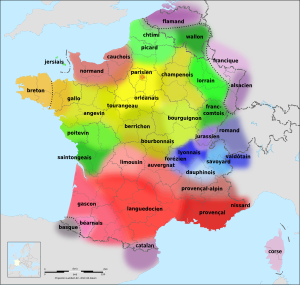Languedoc language
The Languedokische (Occitan lengadocian , French languedocien ) is a dialect of Occitan , which together with the Provencal forms the Südokzitanische. It is spoken in the historical province of Languedoc in the south of France and is considered by some linguists as a reference Occitan due to the lack of a general Occitan written language.
Etymology of the name
The name of the regional variety is derived from that of the historical province of Languedoc . Their name goes back to the traditional term langue d'oc for the totality of the southern varieties of Gallo-Roman, which is derived from the word òc used here for yes , in contrast to oïl (now French oui ) for yes in northern Gallo-Roman. In the meaning of langue d'oc in the traditional sense, the term Occitan , which goes back to a learned Latin derivation, is mostly used today.
classification
Like Provençal , Gascon , or Auvergnian , Languedocian is a regional variety (a dialect) of Occitan , or if you use Occitan, contrary to the research results of Romance studies, not as a uniform language, but as a group of languages ( langues d'oc in the plural) considered one of these languages. Along with Provençal, Languedocian is part of the South Occitan dialect group. Since it is the most conservative of the varieties of Occitan and its language area is also geographically in the center of the Occitan language area, Languedoc forms are often cited as typical Occitan forms. Languedocian is also the basis for one of the written forms of Occitan (the so-called Reference Occitan), which was developed by the Institut d'Estudis Occitans in the mid-20th century and is used today among other forms in regional cultural institutions and in optional Occitan teaching in education .
distribution
The traditional language area of Languedocian roughly corresponds to the historical province of Languedoc and thus most of the former regions of Languedoc-Roussillon and Midi-Pyrénées . It extends from the Rhone , which roughly forms the border to the relatively closely related Provencal , and the coast of the Mediterranean Sea in the east to the Garonne in the west, along which the border runs to the Gascon , which differs significantly from Languedoc. In the north, the northern dialects of Languedoc in the southern part of the Massif Central merge into Auvergne and Limousin . In the south, the border with the northern dialects of Catalan corresponds to the border between the historical provinces of Languedoc and Roussillon and thus almost the border between today's departments of Aude and Pyrénées-Orientales , although a small area in the northwest of the department of Pyrénées-Orientales also corresponds to the Languedocian language area belongs to.
Today, Languedocian is only spoken by a minority of the inhabitants of its traditional distribution area, especially in rural areas. Exact figures are not available as there are no official language statistics in France. It is estimated that around 10% are fluent in Languedoc and 20% can understand it. In the urban centers of Toulouse and Montpellier hardly anyone speaks Languedoc as their mother tongue, but the written form of Occitan based on Languedoc is used there in cultural institutions and taught as an optional subject at schools and universities.
See also
literature
- Louis Alibert: Dictionnaire occitan-français d'après les parlers languedociens . Institute d'études occitanes, Toulouse 1966.
- Pierre Bec: La langue occitane . 5. édition mise à jour. PUF, Paris 1986, ISBN 2-13-039639-9 , ( Que sais-je? 1059).
- Günter Holtus et al. (Ed.): Lexicon of Romance Linguistics. (LRL) . Volume 5: Lexicon of Romance Linguistics , Part 2: The individual Romance languages from the Renaissance to the present: Occitan, Catalan . Niemeyer, Tübingen 1991, ISBN 3-484-50335-1 .
